
by Diane Van Cort
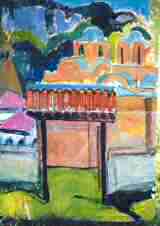
Diane Van Cort: Painting of a monastery
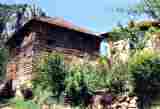
An ancient village
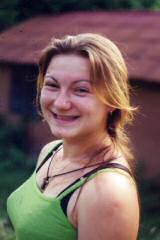
Dushita, a farm girl
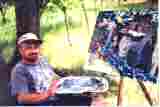
Kostos and his painting
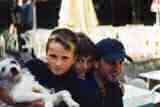
Michael and children
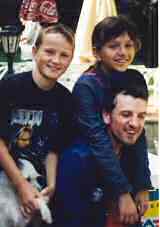
Michael and the kids
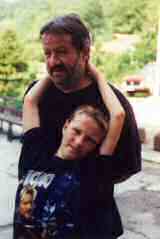
Mitka and son
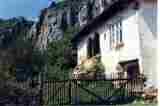
Monastery
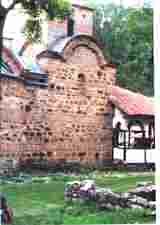
Monastery, rear
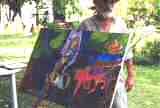
Philiman
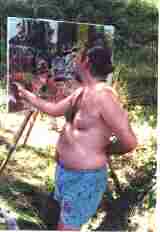
Rumous
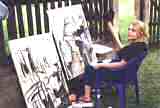
Shashko at work
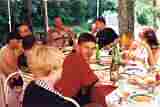
A typical lunch
Part 1 appears in ARTEZINE 8.
Van Cort has arrived at her destination, a residency program for artists in the rural environs of Serbia. She is in the company of fellow artists who are also part of this program.
We, as women, were prohibited from staying at the Monastery, as now it is run by a male priest. Formerly it was run by less sexist nuns.
Our farm hostel is owned by two women, mother and daughter. Here it was cozy and quiet with wool blanket cold starlight nights. Mornings I would open the window to bird twitter and fresh mountain air.
I slept well on the lumpy bed in my own room while my two female cohorts share a room, one of whom never stops talking or smoking. Our hosts slept together on a couch in the room that served as kitchen and main area. Serbian people are physically in touch in a very simple way. There seem none of the self conscious Freudian constraints. I saw time and again fathers and daughters chummy as lovers and sons easily embraced. I didn't see hitting or hear yelling but it was probably there. Life seemed more tranquil.
Each morning after Turkish coffee we were picked up by our manager,Mitka, and taken to breakfast across the road from the Monastery at the restaurant. Mitka had also to get the couple Iíd come with, the painter, Philimer, his daughter Lada and companion, Roshitsa who had had to stay elsewhere as the farm hadn't a room and the Monastery refused females.
They stayed in an exceedingly ancient, tumbled down, frozen in time village. I saw a water pump outside their cottage so they had running water of a sort. On our visit we walked its ancient dirt and rock straight up, vertical roads, we peered at straw hay barns and mud, stick, and clay picturesque walled red tiled roved dwellings and picked some berries and the ubiquitous plumb but I saw no people. Chickens and drying tobacco leaves near the river were the only human signs.
After breakfast and lunch we artists took our spots on the Monastery grounds and painted having been given two 24 X 36 inch canvases plus paint. The others had brought their own brushes which I had to borrow. These works were collected by the Colony which was the sponsor. They would travel in shows. I never heard anything about it afterward. In any case this deal seemed standard. I hoped to finish mine and to do some watercolors which I did. The Bulgarians took their paintings with them as did Philimer. To send back later?
We were housed and fed and taken on jaunts, picked up by Mitka daily, a terrific and sweet man with a nine year old son always along in a Russian jeep. He was apparently very funny (spoke no English) and as he looked slightly like Robin Williams was told to go to Hollywood all the time. He was actually a sculptor who at trips end took us to his studio in Dimitrovgrad (small city where we had first arrived) and gave us each a small abstract ceramic sculpture of his. That fall he was having retrospective in Belgrade.
The painters were Dean, a young newly married Serbian art professor who spoke excellent English and translated for Michael, the Englishman and me as well as Kostosthe, a Greek, late 30s and a university teacher in Athens. The two very jovial and hard drinking Bulgarians; Ruman a dark 40ish something with his hair in a ponytail and a beautiful tranquil face and his pal, Duchin, who reminded me in appearance of Truman Capote and who had lived in New York and been on the art scene there and knew and thus spoke excellent English. Also there was Peter, a middle aged man very devoted to the Serbian church and spoke very little English, and the couple; Philamer, a well known painter and his curvaceous girl friend painter, Roshitsa, both of whom spoke almost no English, and his daughter Lada, the charming preadolescent who spoke good English, and my Serbian farm hostel mates: the two women painters, Satchko, a young plump version of Michelle Feiffer, and Yellie, a married pleasant matronly blonde both of whom I could easily have conversation.
Here was this outdoor restaurant, umbrellas over long tables standing on a platform above the road across from the ancient Monastery (hidden by a stone wall and trees) was the hub of the colony and occasional visitors from the press and god knows who else but most likely members of the cultural center (our sponsors). We were served a pretty much what we had first been served in Dimitrovgrad. The breakfast was bread and cheese or oatmeal or polenta and an occasional soup for lunch. The salad was always cucumber and tomato and of course all we could drink of wine, beer (pivo) and raki (regional plumb brandy). The women hardly drank, but I drank as much as I could tolerate with the approval of the men but it was still nothing to brag about. The Bulgarians and Michael were often hung over.
The countryside was very beautiful with craggy mountain rocks near the roads, a swift little river called Yerma, forests, meadows, fields, and berry bushes, ancient orchards, and plumb trees.
One of the more vivid memories for me now was of the young priest, who had waist length black hair, riding his horse in his church robes looking forbidding and picturesquely medieval. He was very tall and gaunt to begin with.
The stone monastery itself was actually 4th Century architecture with designs that were made by placing colored stones in bands around the building. There were some stylized iconographic frescoes inside that visitors came to see.
Another memory was that of a mountain woman I met while out painting along the road with the vast vistas of overhanging mountain cliffs, sky, and water tumbling over rocks. She was suddenly there speaking to me. She was toothless and wearing a long skirt and plastic shoes. Her hair was grayed and cut short She was very lean. I couldn't make out what she was saying though she said it over and over. At last she moved away switching a stick at her cow (who seemed to me enormous) that she had brought along to graze.
I learned that she lived alone in the mountains with her twelve year old son. I saw her at another time near the restaurant talking with people, so she was not as hermetic as she appeared. But imagining her getting along in a rustic shelter in the winters by herself was confounding.
The villages themselves were so other-century that to live in one seemed fearful enough without living apart in freezing temperatures.
Time flew painting in the country, having rowdy meals at night. The children fell in love with the young Englishman, Michael, and clung to him so that he could hardly work. At meals they and he made the grotesque faces at each other and generally carried on.
The Bulgarians took on the role of drinking masters and encouraged Michael, who needed no encouragement, to be an alcoholic meditator. There was constant toasting and general idiocy but I was happy to eat at the farm one night with my female hosts where we made a simply meal from the garden with cheese but no meat. I photographed the young 20 year old daughter, another blond pretty girl who had walked seven miles to school as a child, spoke good English and had no desire to venture away, having spent some time in a city going to high school. Leaving her mother had been unbearable. Now the two of them lived alone as the father had died. She hoped to marry and continue with the farm. Her mother was a cook at our restaurant.
After more than a week of continual painting,the painters who were by and large abstractionists, were finished or close to and we had a wide variety of work. Mine, which I did of the Monastery was daubed Fauve by Kostos for its color, and he had done a sort of mythical version with a priest on a horse. My female house mates did cubistic abstractions of the rocky mountain overhangs while Roshitsa painted an abstract icon of a saint. Philimer did an abstract painting uninfluenced by the surroundings. Peter did a sweet primitive impression of the Monastery. The Bulgarian work was purely abstract and Dean did an abstract impressionistic painting of the cliffs.
Michael unable to finish,due to constant attention of children, had begun a complicated drawn and painted graphic piece which did not seem to relate to the colony experience at all.
The one thing rarely discussed was politics although Serbia had been bombed by the United States in order to stop the terrible ethnic cleansing.
Thus I was taken in other places to see bombed out sites such as the Chinese Embassy in Belgrade and a what had been a fruit canning factory in Valjevo, whose destruction put several hundred people out of work forever.
I had made an attempt to understand the country by reading the classic book of Rebecca West Gray Falcon, Black Lamb where she writes about the ancient Balkan ethnic hostilities and the historic raw deals Yugoslavians got forever from their European neighbors. I could not understand easily and felt I would never really get the whole truth. Still, I listened to one exposition by Dean (a Serb) about Kosovo and the Albanians. Now the war having ended the Serbs can legally return to their homes but if they do they will be murdered in the night, therefore they sell and move. Dean says the Albanians have much money from European connections and Mafia having to do with drug and weapons running. He was talking to Kostos the Greek and me. Kostos had been forcibly demanded a bribe by the police in one of the border countries on his way to Serbia from Greece.
Our last outing from the colony was to take our Bulgarian companions back to Sofia, in Bulgaria where they lived, painted and taught at the Art Academy. We had been this whole time only a few miles from the border but Sofia was hours away. Our trip had of a lot of stops at the borders to pay visa fees both ways. We rode through miles of flat sunflower fields until we reached the city.
A pretty city I thought, large Avenues, old ornate stucco architecture, cobbled streets, dormer windows. Official looking buildings and wide avenues that made Michael say the place looked Russian. We had coffee at a cafe near a large park where we left the Bulgarians to their beer after a photo session. From there the trip degenerated as we went to a BJ type place called the Metro out of Sophia where everyone but me and Michael shopped their hearts out for hours. I did buy one cheap small wheeled luggage but I had little money because of visa fees.
Finally after a lot of ordeals getting back through customs on our return to Serbia we (the few of us that were left) arrived around 11:00 PM in Dimitregrod to be put up gratis in the Hotel Balkan, a fine but sort of drab, run down hotel. I prepared to sleep the sleep of the dead but instead was kept awake all night by the most extraordinary loud hollering of drunks Iíd ever heard anywhere, at any time. No one else found it all strange.
From here we were taken to sight see another really lovely less ancient and in the process of being restored Monastery high above the city and also to Mitkas sculpting studio. Finally we, in the late afternoon boarded the train for Belgrade.
The colony had been one of the main highlights of the trip, with its beautiful setting, generous sponsors, farm hosts and international painters.
There was left, however, the opening of the American show. This was of the work I had brought over of my own fellow professional artists. This required another trip to the city of Valjevo to the International Gallery where the show had been put up in my absence.
Our exhibit was very well hung and lit. Our show was a hit with the public I was told. The works supported each other: Robert Sievert, with his wonderful black and blue oil abstract Harbor nights, Marion Lane and her pleasingly colored nonobjective abstract pastel and water colors, Elisa Decker had carefully designed and delicately executed beautiful portraits, Myron Rubensteinís quirky illustrative ink and painted surrealism, John Silver's small very fine water colored abstracts, and my expressionistic water colored nudes and landscapes. Mica (pronounced Meecha) had done a fine job of supervising everything and his framing buddy had more than outdone himself.
Mica loves partying, limelight and having a gallery. Being an international painter of some repute he is quite a star in this city of his birth. At the opening he had a choir and a band playing outside and we were both in the gallery and on the terraced steps. It was a pleasant warm August night.
Perhaps 100 people showed up as well as the media. I spoke with the gallery women and some wives I had met as well as Batta and others. I actually met no new people (not speaking Serbo-Croatian which relates to no language I know did not help).
But of course I was interviewed by the local TV in English. Here I was finally asked to comment on politics. I had no trouble giving my pacifist viewpoint which certainly negates bombing and war generally. Also it was known that I had made a trip to Washington to demonstrate.
After the opening we went to a large feast at a hotel where the board members of the gallery had been invited along with myself and Mica, his wife and the gallery workers. This place really looked soviet inspired: dark paneled wood, seedy old carpets, and other signs and smells of another age.
There was a huge table in a dimly lit room set for perhaps 30. It must have been eight feet across to my neighbors, Philimer and Roshitsa who kindly came down from Belgrade for the opening and with whom we exchanged winks and grins as we were deficient in each other's languages.
Jovial Mica carried on with jokes and merriment and toasts and the food was very good but similar to everything else Iíd eaten. Here I was lucky to have fish.
At the dinner I meet a surgeon who has an acupuncture clinic outside of his hospital job. Since I have experienced this therapy I arrange for a treatment. My back has been killing me since the sleepless night in the Balkan Hotel and the toll of all the combined travel.
Dinner winds down. Thankfully Mica was boisterous because the others are rather quiet and polite and the wives aside from Mica's Dushitsa and Roshitsa seem not to exist. They are a matronly lot, perhaps not used to being out. This is more formal than at the colony and as I am the center I enjoy it less though really it is Mica who is the attraction. His compatriots love and admire him. Men in Eastern European countries have tremendous camaraderie. People are kind and as I say they approve of my politics although they don't know that secretly I believe that war, no matter by whom, is a business of horror where denial prevails. The tangled web of nationalism is for me too much to comprehend. Besides I am here for cultural exchange not politics.
Still I am aghast when I do see bomb craters and hear how frightened the ordinary citizens were listening night after night to air raids and explosions. For an American it is basically an unimaginable experience aside from our very terrible 9/11.
When I go to the hospital the next day, picked up by the surgeon and his astonishingly tall dark and beautiful eighteen year old daughter. I am told of the awful bomb detonation that went off near the hospital and was also near their home. I am struck again about how terrorizing this must have been.
We visit the doctor's main place of work before the acupuncture clinic. It is a drab and dreary hospital. It is a large official looking cement building, old and slightly crumbling, low lit inside with a walls in need of painting. It is a sad place and he has a very small office. I don't see anything more. I understand his salary is very little. I forget to tell him that in the States the extraordinary costs of a medical education, and the insurance battles make this profession less and less desirable and available for us.
The acupuncture clinic of his is a simple room in a house half of which is curtained off. When Chinese medical doctors came to instruct he was so interested that he paid for himself -- the hospital was unwilling to do so.
Unfortunately Serbian people are superstitious and prefer witchcraft. He tells me this when I ask if acupuncture is popular. His needles prick me more than others I have had, but the next day I am miraculously relieved of my back pain. He says I need many more treatments (another reason it is not popular) But this is not possible. During the treatment we are serenaded by a Serbian pop tune on the radio which strangely has an Arabic beat.
The doctor is a tall and dark, mustached and handsome man in his late 40ís, his daughter, Svetlana, says he had been fighting in the war for four years. I hate imagining this, as he seems a sweet and generous person. She loves him dearly, kissing him on the top of his head where he has lost hair. She says it is from wearing the surgeons cap.
I am near the end of my raison d'être for the trip with one more day. Then on to Beograd or Belgrade and the flight to Prague, a city where I will stay a few days despite its having been flooded for weeks and at one point immobilized. Mica doesn't understand why I want to stop there, who needs to see anything other than Serbia? It is true I've barely seen Belgrade but truthfully I am longing to be on my own, having had every move choreographed. At times it was necessary and very comforting. It also becomes wearying.
Before I leave Valjevo I take the latest hard cover book of Mica's art works and purchase it. It is the only thing I can think of to show my gratitude for all his kindness. I am glad to have his works to refer to as an artist of merit. It is a well produced book and done by the same printing factory that produced our catalog of "Art Without Limits", the American exhibit I brought over and so named by Mica. Months later the works will be returned to us by being hand carried in a portfolio from Serbia. A near disaster doing this will have almost occurred but thankfully was, nonetheless, averted.